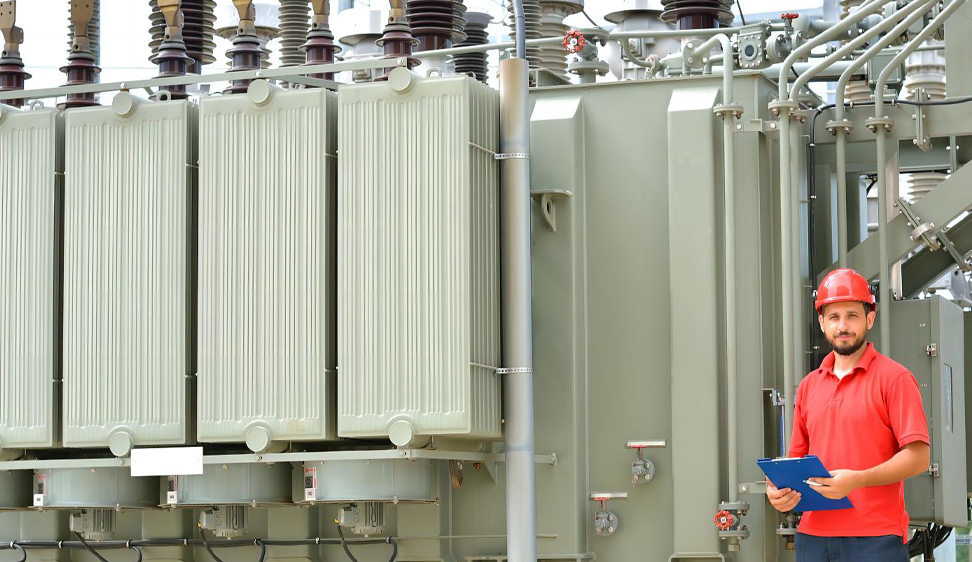What is High Voltage Switchgear?
2024-04-16

High-voltage switchgear plays a crucial role in electrical grids and high-tension power distribution systems. It ensures the secure and effective transmission of electrical power by offering a way to disconnect and separate electrical equipment from the power source safely. Learn more about this specific type of switchgear here.
1. The definition of High Voltage Switchgear.
2. The application for High Voltage Switchgear.
3. The components in High Voltage Switchgear.
4. The operating principle for High Voltage Switchgear.
5. Types of High Voltage Switchgear
6. Maintenance for High Voltage Switchgear.
1. The definition of High Voltage Switchgear.
What is High Voltage Switchgear?The High voltage switchgear is an integral component of power distribution systems that ensures the reliable and safe distribution of electrical power. It is specifically designed to handle high voltage levels, making it an essential part of large-scale power grids. The primary components of high-voltage switchgear include circuit breakers, switches, and fuses, which work together to regulate and protect the flow of electrical current. These components are engineered to withstand extreme voltage levels and operate efficiently under high-pressure conditions.
High-voltage switchgear operates at the intersection of several essential electrical components, such as switches, fuses, transformers, relays, and disconnectors. These components work in tandem, each playing a unique role, to facilitate the efficient and safe distribution of electrical power in networks that operate at voltages exceeding 36kV. Their collaborative function is what makes high-voltage switchgear a reliable and integral part of power distribution systems.
2. The application for High Voltage Switchgear.
High-voltage switchgear is widely used in various industries and electrical environments, as it is designed to handle voltage levels of 36kV and above. As a result, these systems are commonly found in facilities and installations that require high-voltage power distribution and control.
Switchgear is utilized in various settings for different purposes. It is employed in power plants to safely disconnect generators and other equipment from the grid, on electricity transmission and distribution networks to link or unlink sections of the network,in substations to connect or disconnect transformers, capacitor banks, and other equipment, and in large industrial and commercial premises to attach or detach equipment from the power supply or operate large motors.
The main function of switchgear in these environments is to safeguard equipment and personnel from the harmful consequences of high current faults. Additionally, high-voltage switchgear is utilized to regulate the flow of electricity within the grid and to separate equipment for maintenance or repairs.
3. The components in High Voltage Switchgear.
To comprehend the functioning of high-voltage switchgear, it's essential to familiarize oneself with its constituent parts. Although there are several components, we will focus on the primary elements. The primary components of HV switchgear, found in both indoor and outdoor versions, are:
Circuit Breakers
The circuit breaker, a crucial component in high-voltage switchgear systems, is an electrical switch designed to automatically protect a circuit from damage by overload or short circuits. Its sophisticated design allows it to act within milliseconds, swiftly removing excessive and fault currents, thereby safeguarding the entire system.
Instrument Transformers
Instrument transformers, integral to high-voltage switchgear systems, serve as essential measurement tools. Comprising current transformers (CTs) and voltage transformers (VTs), their primary function is to lower current and voltage levels. This reduction enables the safe monitoring of electric system flows, triggering protective relays or transmitting fault signals to the control center.
Earthing Switches
The earthing switch, a safety-critical component in a power system, plays a vital role in ensuring the safety of both the system and its operators. It achieves this by establishing a connection to the ground when the isolator or breaker is opened. This action dissipates any lingering electrical charges in the line that has been disconnected from the power source, thereby preventing hazardous situations.
Step Up/Down transformer
The biggest and most costly components of high-voltage switchgear are the step-up transformer, which raises the voltage of an electrical signal for efficient long-distance transport with minimal power loss, and the step-down transformer, which lowers the voltage before it reaches equipment that cannot handle high voltages.
Disconnecting Switch
In high-voltage switchgear systems, disconnectors serve as straightforward mechanical switches that can interrupt or reestablish an electrical circuit. They are typically utilized to connect or disconnect equipment from the power source, usually for maintenance or repair work. These components are also referred to as isolators.
Relays
A relay is a switch that is controlled by electricity and can be utilized to activate or deactivate a circuit. Protective relays are designed to identify issues in the electrical system and trigger the circuit breaker. This breaker then isolates the defective equipment from the power source and assists in quenching any resulting electrical arcs.
Busbars
Busbars are conductors with low impedance that link electrical equipment. In high-voltage switchgear, busbars connect high-voltage circuit breakers and other components to facilitate the transmission of power between different points.
Surge Arresters
A surge arrester is a tool that safeguards equipment from harm due to sudden high voltages, like lightning strikes and other sources such as switching surges. High-voltage switchgear arresters work by absorbing the surge's energy before it can harm the equipment.
Batteries
Batteries serve as a secondary power source in numerous high-voltage switchgear setups to ensure continuity during power interruptions. They supply sufficient power to sustain the operation of the circuit breaker and other high-voltage elements, allowing for a safe disconnection from the main power source.
Earthing Grid
An earthing grid, consisting of metal rods or plates buried in the ground, is used to redirect electrical energy into the earth. By doing so, it safeguards equipment from harm due to lightning strikes and sudden increases in voltage.
4. The operating principle for High Voltage Switchgear.
Now that we've gained a solid understanding of the fundamentals of high voltage switchgear and its various components let's delve deeper into its mechanics. Here's a concise overview of its operation.
The primary function of high-voltage switchgear is to provide a safe and reliable means of distributing high-voltage electricity. To achieve this, various devices are used to measure power flow, regulate it, and detect and isolate faulty circuits from the rest of the system. During the operation of a switchgear breaker, the current transformer or protection relay detects high voltage current. It activates the circuit breaker, which interrupts the flow of current and protects electrical equipment from damage. In addition to automatic functions, some high-voltage switchgear operations can be performed manually, such as isolating equipment or lines using the disconnecting switch. The high-voltage switchgear market offers a range of equipment with monitoring mechanisms to ensure proper operation and maintenance of the installation.
The high-voltage switchgear and control gear are equipped with an array of sensors and a state-of-the-art control panel. The sensors continuously monitor the system and transmit data to the control panel for processing and analysis. If any anomalies or issues are detected, the control panel initiates preventive or corrective measures to ensure the system's smooth operation.
5. Types of High Voltage Switchgear
High voltage switchgear can be broadly classified into two categories: air-insulated switchgear (AIS) and gas-insulated switchgear (GIS). AIS switchgear relies on air as its primary insulating medium, whereas GIS switchgear employs gas, typically sulfur hexafluoride (SF6), for insulation purposes. Here's a more in-depth look at the differences between the two types of high voltage switchgear.
High-voltage Air-insulated switchgear
Air-insulated switchgear for high-voltage applications is commonly utilized in outdoor settings, including substations, power plants, and various electrical distribution systems. While this type of switchgear is cost-effective and simple to upkeep, it is susceptible to environmental factors like dust, humidity, and salt air, necessitating more frequent maintenance compared to gas-insulated switchgear.
High-voltage Gas-insulated switchgear
Gas-insulated switchgear for high-voltage applications is a more space-efficient alternative to air-insulated switchgear. It is commonly installed indoors in areas with sufficient space. While gas-insulated switchgear may come at a higher cost compared to air-insulated switchgear, it provides various advantages, including a smaller size, improved reliability, and lower maintenance needs.
6. Maintenance for High Voltage Switchgear
The efficient operation of numerous electrical systems relies heavily on high-voltage switchgear. After selecting the most suitable type, the next step is to install the equipment properly. Once the installation is complete, it is essential to adhere to the manufacturer's guidelines for maintenance to ensure optimal performance and longevity.
Adherence to usage guidelines provided by manufacturers is crucial for high-voltage switchgear users. These guidelines often come with maintenance instructions and training for personnel. Typical high-voltage switchgear maintenance tasks include:
HV Switchgear Preventive Maintenance
Scheduled maintenance activities for high-voltage switchgear are aimed at ensuring the equipment remains in optimal condition. The main goal is to enable electricians to detect and address any issues before they escalate. The maintenance program encompasses:
Maintenance tasks include scrutinizing the high-voltage switchgear for loose bolts, wear and tear, and other potential problems. Cleaning the parts is also crucial to prevent dirt and debris accumulation. Additionally, tests are conducted following strict safety protocols, and adjustments are made based on the switchgear's condition. Calibrations are also performed to ensure the accuracy of the various components.
HV Switchgear Corrective Maintenance
High voltage switchgear maintenance is carried out when there are signs of an issue or when preventive maintenance suggests a potential problem is on the horizon. This type of maintenance encompasses the following activities:
Identifying the main reason for the issue through troubleshooting, fixing any problems found through repairs, replacing severely damaged parts, and making changes to enhance the switchgear's performance or fix any design issues.
In summary
High voltage switchgear plays a crucial role in every electrical system. This guide has outlined the various kinds of high-voltage switchgear and the factors to consider when choosing, setting up, and maintaining the devices. Armed with this knowledge, you can ensure that your high-voltage switchgear is capable of delivering power to your electrical system in a safe and dependable manner.
When selecting high-voltage switchgear for a specific use, it is crucial to take into account the project's unique requirements. Various factors, including expenses, spatial limitations, upkeep needs, and environmental factors, will all impact the choice of switchgear that is most suitable for the task.





